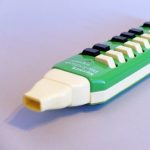New melodica build video
- This topic has 17 replies, 6 voices, and was last updated 2 years, 5 months ago by
 Daren.
Daren.
-
AuthorPosts
-
January 17, 2021 at 9:41 am #13156
 DarenKeymaster
DarenKeymasterI started filming bits of my melodica making process last year. When I looked through it, I realised I had enough to make a start to finish video, which was never the original plan. I’m happy with this instrument – it has a good tone, and plays well…
January 17, 2021 at 12:31 pm #13157Connell
ParticipantI got a look at your video yesterday Daren. Wow! That blew me away. I’ve been searching for a melodica with accordion or concertina reeds too and it was looking like I was going to have to Frankenstein an accordion and melodica. As someone who has a melodica with accordion reeds what’s your view of the difference in sound between yours and say a Suzuki 44H?
January 17, 2021 at 12:51 pm #13158 DarenKeymaster
DarenKeymasterHey, thanks for watching! It’s a long time since I’ve played a Hammond 44, so I can’t do a direct comparison. From memory, my instrument has a cleaner tone. Its less fuzzy, which is great, but also more challenging to play, because I find I have to be more accurate!
January 17, 2021 at 5:07 pm #13159Connell
ParticipantLooks and sounds fantastic, let me know if you fancy taking commissions!
January 20, 2021 at 4:57 pm #13175 André Sant’AnnaParticipant
André Sant’AnnaParticipantI really loved to know your melodica building process, Daren.
So instructive and delightful. So many details to worry about.
One question: It seems to me that the internal parts printed in 3D was inspired by the Yamaha model (with some changes, of course) but you used single reeds in your project. Did you have to change the size of the place where to put the reed in comparison with the Yamaha’s reed plate? I don’t know if I made myself clear, haha
Thanks for sharing!
January 20, 2021 at 5:07 pm #13176 DarenKeymaster
DarenKeymasterDid you have to change the size of the place where to put the reed in comparison with the Yamaha’s reed plate?
Yes, I learned 3D design originally from reconstructing a Yamaha P37D. I actually lost that file! But this one was based on the same principle, but has different dimensions everywhere. I think I kept the key size exactly the same. I actually wanted to see what the P37 would sound like with single reeds, and tried some modification experiments, and couldn’t get it to work. This one has different reed chamber sizes, and a place to put a steel rod (like the Hohner Pro 36), some guides for the keys etc
Looks and sounds fantastic, let me know if you fancy taking commissions!
Thanks Conner, I’d love to start making them, but they just take too long!
January 23, 2021 at 10:20 pm #13180 Alan BrintonParticipantJanuary 24, 2021 at 11:32 am #13181
Alan BrintonParticipantJanuary 24, 2021 at 11:32 am #13181 DarenKeymaster
DarenKeymasterThanks Alan! It feels good to have arrived at an instrument I’m really happy with after so many years. I hope one day you’ll be able to try it!
January 27, 2021 at 8:36 am #13182 MaxParticipant
MaxParticipantVery interesting stuff! Thank you for sharing!
January 29, 2021 at 3:08 pm #13185 DarenKeymaster
DarenKeymasterGlad you liked it Max 🙂
October 10, 2021 at 9:17 am #13781 Rey FlorianParticipant
Rey FlorianParticipantHi Daren and all the melodica players,
I have been a member of the melodica world forum for a while but I am not very active digitally. I live in the south of France in Toulouse, and your website reminds me that there are plenty of other lovers of this beautiful instrument.
I want to thank you for everything you do because you make the melodica accessible to all and more than that you bring the nobility that people do not know it.
Amateur pianist, I got into melodica first to play with my band in acoustic jams, then I had a lot of fun and I continued.
One day, I came across your website and following your advice I had to relearn how to play this instrument. First by closing my eyes, then replacing the plastic pipe with the mouthpiece.
it was very painful, but it was worth it.Having listened to your advice, I have been playing a P37D for about 5 years, and I’m happy about it except that the saliva gets stuck too often in the reeds. It must be the same problem for everyone.
——-
I just came across your video, it inspires me and makes me want to create my own melodica.
Would you like to share your 3D file so that the community can try to reproduce a similar melodica and could you tell us which plastic material you used for this realization?
I would really like to try to reproduce your melodica, from your video and I think that with a little further work this can be done.
I think the only thing that may be missing concerns the 3D part because it seems to me that this version is more advanced than the one you have previously designed. And maybe also the shopping links like for example the springs or at least their dimensions, the felt or that kind of thing.
In any case, I wish you good luck and thank you again for creating this website and sharing your knowledge.
October 10, 2021 at 8:47 pm #13782 DarenKeymaster
DarenKeymasterHi Rey, great to hear you’re doing well with the melodica, and that hear you’re interested in making one.
For 3D printing, I started out using FDM (fused deposition modelling), but it wasn’t accurate enough. For the instrument in the video, I used a process called SLS (selective laser sintering), where a powdered resin is fused together with a laser. SLS is very expensive, but in my experience necessary when you have 34 moving parts which need to create airtight seals.
I change the design every time I make a new instrument, and like to try out different materials and manufacturing processes when I can. Remember, although the 3D printed section is a crucial part of the instrument, it’s only a part of the it. As well as the reeds, I add machined metal parts, leather, rubber, wood and various other materials. These all have to be designed along with the 3D printed parts for it all to work together. When I have all the parts, they never work quite as planned, so I normally have to revisit the design.
I encourage you to go through the same process as I did – make your own file by taking your favourite melodica apart, and recreating it. That way, you’ll gain a working knowledge of the instrument, and be able to troubleshoot when things go wrong. You’ll also then have the confidence and ability to make improvements tailored to your needs and taste.
Please report back here with any progress!
October 15, 2021 at 5:41 am #13787 Rey FlorianParticipant
Rey FlorianParticipantHello Daren,
I am a little disappointed with your answer and at the same time I approve it at 100%.
I suspected that walking on the voice of the melodica creator would not be plug and play 😉I reviewed your video, and I noted each passage to better understand the stages of building of your new melodica. I understand better indeed the difficulty of arriving at this amazing instrument, and the years it will have taken you to achieve this manufacturing process.
I particularly remember the fixing of the reeds with beeswax. 🐝
For the 3D part, I will start to take it easy because it could be a big job and I already spend too much time on my computer at work 😉 because i am software engieneer. 💻
I read that you were using particular software which seemed to be in development at the time.
I’m using software which is currently in development, so not commercially available now. I’m not sure what options are out there. I’ve heard of Rhino and Blender (which is free), but haven’t used them.
What about the 3D software you use today?
Can you give us your feedback on this experience, because by reading your blog I did not find the name of the software.
Have a nice day.
Thx
October 21, 2021 at 11:36 am #13790 DarenKeymaster
DarenKeymasterSoftware is not something I can advise on, as I’m using software that is in development. There’s a big choice of similar CAD software out there, and everyone has their own preference. Rhino looks good to me.
Great that you’re a software engineer, this should really help – what’s your area?
November 20, 2021 at 2:18 am #13808 André Sant’AnnaParticipant
André Sant’AnnaParticipantHaving listened to your advice, I have been playing a P37D for about 5 years, and I’m happy about it except that the saliva gets stuck too often in the reeds. It must be the same problem for everyone.
I went the opposite way in relation to the mouthpiece precisely because of the amount of condensed water that interrupts the reeds. I began to understand why Japanese melodica players often use the flexible tube, in addition to making it possible to play the instrument with both hands. The amount of condensed water decreases drastically and now I only have a problem with the reeds getting stuck if the weather is cold and I play for hours at a time. Most of the condensed water remains in the flexible tube.
-
AuthorPosts
- You must be logged in to reply to this topic.

